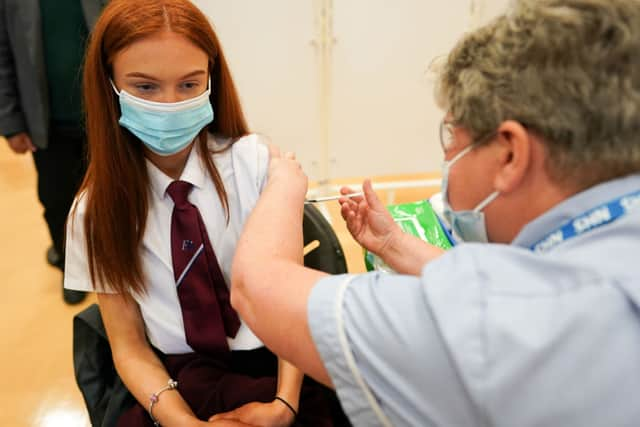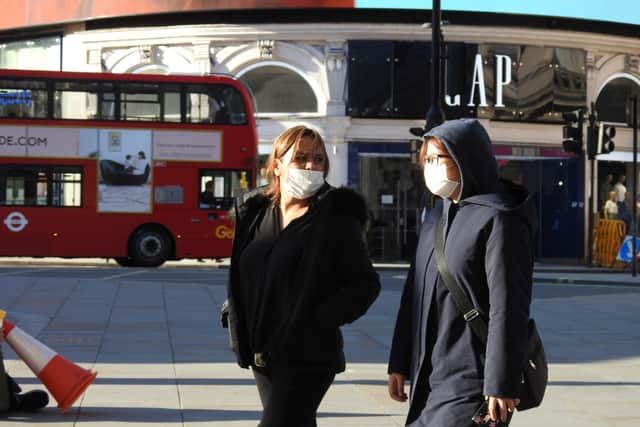Covid-19: where in Greater Manchester has seen the biggest rise - and drop - in infections?
and live on Freeview channel 276
The 20 areas of the region that are continuing to be worst and least hit by the virus have been revealed on Tuesday, with infection rates continuing to top a thousand in several locations.
Parts of Bolton, Bury, Manchester and Salford are recording the lowest infection rates in the conurbation.
Advertisement
Hide AdAdvertisement
Hide AdHowever, the number of neighbourhoods where cases of coronavirus are in single figures has dropped to just two.
While Trafford is still dominating the ten major hotspots, a pair of Stockport areas have taken the top two spots.
The region’s Covid-19 hotspots and ‘notspots’ have been identified through an interactive map which charts the number of positive test results in each neighbourhood across the country using government data.
It shows the number of infections per local area, broken down into neighbourhoods containing roughly 7,000 people.
Advertisement
Hide AdAdvertisement
Hide AdThe number of new cases is then used to calculate the infection rate per 100,000 people.
Heaton Moor in Stockport has become the worst hit area, according to the latest data in the week to October 13.
It recorded an infection rate of 1,282.1 per 100,000 people – with 82 new cases.
This is an increase of 33 from the previous week, a 67% rise.
Advertisement
Hide AdAdvertisement
Hide AdSecond highest is Cheadle Hulme South East, also in Stockport.
The localised infection rate there was 1,107.6 after 81 people tested positive.
In third place, is Urmston West in Trafford, which has been in the top 10 for several weeks.


Despite a high infection rate of 1,087.3, cases are decreasing in the neighbourhood with 75 recorded, a reduction of 13.
Advertisement
Hide AdAdvertisement
Hide AdFlixton and Moorside in Trafford follows with 81 cases, which equates to an infection rate of 1,002.8.
It is followed by Timperley North where the infection rate has dropped below a thousand to 930 per 100,000 people.
There were 79 cases in the neighbourhood, a reduction from 13 from the previous seven day period.
Lostock and Stretford Meadows in Trafford becomes one of the worst hit areas after cases increased.
Advertisement
Hide AdAdvertisement
Hide AdThere were 64 cases, a rise of 10 which equates to an infection rate of 924.5.
The Stockport area of Bramhall North West follows with a rate of 922.2, and 55 cases – an increase of 11.
Eighth placed is Davyhulme, also in Trafford, which topped the leaderboard last week.
Its infection rate stands at 921.7, with 77 new cases being recorded in the week to October 13.
Advertisement
Hide AdAdvertisement
Hide AdHowever cases are dropping fast in this neighbourhood, with 39 fewer than the previous week.
Sale Moor in Trafford has seen a small spike of 13 new cases which puts it into the top ten with an infection rate of 906, and 75 people testing positive.
Lastly in tenth place is Hale Barns, also in Trafford, where the infection rate stands at 876.4 with 73 new cases.
Where are cases going down?
At the other end of the scale Burnden and Great Lever in Bolton has the region’s lowest infection rate at 65.7 per 100,000 people.
It recorded just six cases, down 16 from the week before.
Advertisement
Hide AdAdvertisement
Hide AdFairfield and Jericho in Bury follows with eight cases and a local infection rate of 100.2.
This was also a reduction of eight cases from the previous seven days.
In third place in Fallowfield Central, once an area hardest hit due to outbreaks among the university student population.
However it saw just 13 cases which equates to an infection rate of 109.7.
Advertisement
Hide AdAdvertisement
Hide AdThis is followed by Lever Edge in Bolton, where cases have increased by four, but where the infection rate still remains low at 123.4. There were 11 cases in total.


Another Bury neighbourhood, Fernhill and Pimhole comes in at fifth place with 14 cases and an infection rate of 129.7 per 100,000 people.
Beswick, Eastlands and Openshaw Park in Manchester is next with 16 cases, a reduction of ten from the previous week.
This gives it a localised infection rate of 134.
The Central Bolton neighbourhood is in seventh place with 11 new cases, and an infection rate of 134.9.
Advertisement
Hide AdAdvertisement
Hide AdThe only Salford area in the ‘notspot’ list, Higher Broughton has an infection rate of 143.8, with 23 cases.
Gilnow and Victory in Bolton recorded 14 cases and has an infection rate of 143.9 per 100,000 people.
Finally Rusholme East in Manchester is in tenth place with an infection rate of 147 and ten new cases, an increase of nine from the previous week.